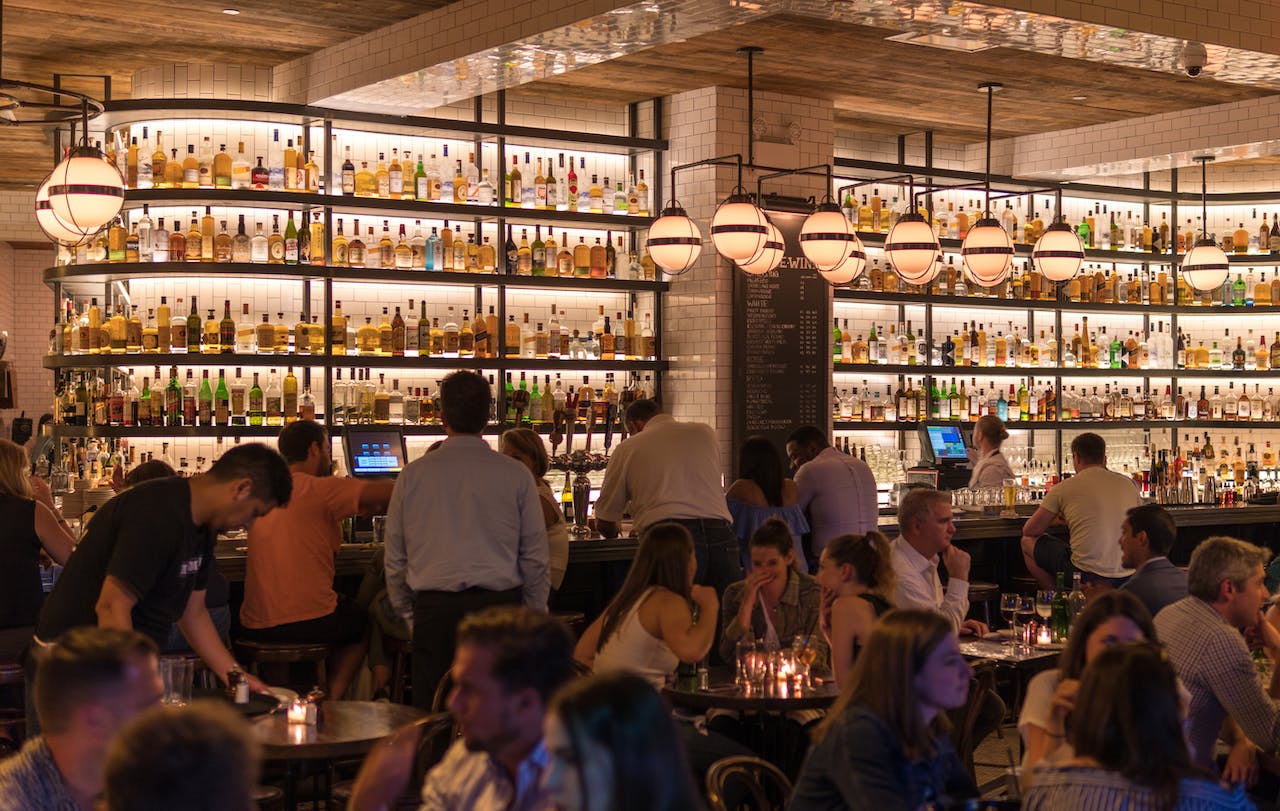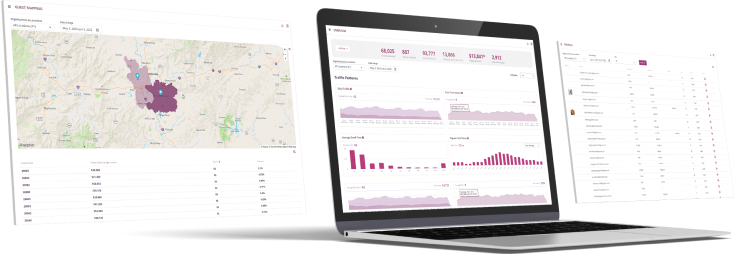Restaurant Target Market - Defining Your Restaurant's Ideal Audience
Refining Your Audience Focus for Happier Guests and Laser-Targeted Marketing Campaigns

Scroll to explore
How To Identify Your Restaurant Target Audience
If you are a restaurant owner or operator looking to gain an edge on the competition, you’re likely searching for that elusive secret ingredient for success.
The secret to unlocking your restaurant’s full potential lies in gathering and leveraging guest data and defining your target market for segmentation.
When you can identify these audiences with precision, it becomes possible to tailor experiences and communications specifically to each audience segment, ensuring that every interaction is relevant and impactful.
In the restaurant industry, where competition is fierce and guest expectations are constantly evolving, the key to success lies in strategic audience segmentation.
By harnessing the power of segmentation, restaurants can significantly enhance their marketing return on investment (ROI) and create a superior guest experience.
This approach not only streamlines marketing efforts but also transforms casual visitors into regulars, which is essential for sustained growth and profitability.

Audience segmentation is not just a marketing tool. It’s a comprehensive strategy that enables restaurants to deeply understand their guests’ preferences, behaviors, and needs.
By dividing the guest base into distinct groups based on various criteria like demographics, spending habits, and visit frequency, restaurants can tailor their offerings and communications. This personalized approach resonates more deeply with guests, making them feel valued.
The impact of effective segmentation extends beyond immediate sales. It paves the way for creating memorable, personalized guest experiences that leave lasting impressions.
When guests feel that a restaurant truly understands them, they are more likely to become enthusiastic brand advocates, sharing their positive experiences with friends and family, and on social media and online review platforms.
The transformative power of audience segmentation in the restaurant industry not only boosts restaurant marketing ROI but also elevates the overall guest experience, turning satisfied guests into passionate ambassadors of your brand.
According to EcoSend, an email marketing software company, in 2023 email marketing generates $40 for every $1 spent. And Mailchimp reports that segmented campaigns boast open rates 14.31% higher than non-segmented campaigns.
At the same time, SuperOffice reports that 89% of marketers do not use segmentation. So, this is the time to gain that competitive edge you’re looking for.
With the right strategies and tools, restaurants can unlock their full potential, leading to consistently increasing revenue and stronger guest relationships.
The Foundation: Collecting Guest Data
The first step in defining your target audiences includes the collection of guest data from multiple sources into a well-structured customer data platform.
Platforms like Bloom Intelligence will collect guest data passively from many different sources, like WiFi logins, POS, online ordering, reservations, website forms, and more. Then the data is aggregated into one customer database.
The system will create individual customer profiles with demographic and behavior data related to each guest.
In no time your database will grow into thousands, or even hundreds of thousands of rich, comprehensive customer profiles. Once you have this large collection of customer profiles, segmentation then becomes simple and easy.

Understanding Audience Segmentation
Understanding who your target audiences are is key to success. By dividing your customer base into smaller groups based on shared characteristics and behaviors, you can tailor your offerings, marketing messages, and overall dining experience to resonate with each segment.
This approach unlocks a world of benefits, including:
- Increased guest satisfaction: Catering to specific needs and preferences leads to happier, more loyal guests.
- Boosted revenue: Personalized marketing campaigns generate higher engagement and conversion rates.
- Improved operational efficiency: Targeting resources effectively reduces waste and optimizes service.
Before getting started, it is important to understand the various ways guests can be segmented into various audiences.
There are 4 main types of customer segmentation available for restaurants that can be used individually or combined for more detailed segments:
Demographic Segmentation: This approach focuses on basic characteristics like age, gender, income, and family size. For example, a restaurant targeting young professionals might offer lunch specials and happy hour deals, while a family-friendly restaurant might target young families.
Behavioral Segmentation: This method analyzes guest behavior, such as frequency of visits, average order value, preferred dining times, and online ordering habits. High-frequency diners might receive personalized birthday offers, while guests who haven’t visited in a while could be enticed with special discounts.
Geographic Segmentation: This strategy divides customers based on their geographic location. Analyzing neighborhood demographics, travel patterns, and local events helps tailor offerings and promotions to specific areas. A restaurant near a college campus might offer late-night study specials, while one located in a business district might focus on catering and express lunch options.
Psychographic Segmentation: This approach delves deeper into customer values, interests, and lifestyles. Identifying segments based on personality traits, hobbies, and dining motivations allows for highly targeted marketing. A restaurant catering to health-conscious customers might highlight its organic ingredients and vegan options, while one targeting adventurous eaters might offer exotic dishes and unique culinary experiences.
Start by spending some time reviewing a few individual customer profiles. Before long, you’ll begin to see similar profiles that you can start mentally grouping together.
These may be close to the ideal customer or specific segments you already had in mind, or you may be completely surprised as to what you discover.
Eventually, you’ll have a much clearer view of the various segments of demographics, psychographics, and behavior patterns within your current customer base.

This is when you can begin creating your list of general customer segments, also referred to as personas or audiences.
These are the personas you will use when brainstorming, creating, implementing and measuring newly created or optimized marketing campaigns to these various customer segments.
Likewise, by implementing these segmentation strategies, restaurants can gain valuable insights into their customer base. This translates into a more personalized and engaging dining experience, ultimately leading to increased customer loyalty, improved customer sentiment, higher profits, and a thriving business.
Leveraging the RFS (Recency, Frequency, Spend) Model
The RFS model is another powerful way for restaurants to understand and segment their guests and it is very helpful in defining the most valuable targeted audiences for your business based on three key metrics:
- Recency: How recently a guest visited the restaurant.
- Frequency: How often they visit.
- Spend: The amount of money they spend per visit.
Recency
Recency is crucial because the more recent a guest’s visit, the more likely they are to return.
For example, a guest who dined a week ago is more likely to return than someone who hasn’t visited in six months. Restaurants can use recency data to re-engage guests who haven’t visited recently with targeted offers.
Frequency
Frequency helps restaurants identify their regulars. High frequency patrons are guests who visit often and are crucial for steady revenue. By recognizing these frequent guests, restaurants can offer loyalty programs or special discounts to encourage continued patronage.
Frequency can also be used to identify guests who have stopped visiting so restaurateurs can re-engage them.
Spend
This metric helps restaurants understand how much guests are willing to spend. Guests who spend more per visit can be segmented and targeted with upselling opportunities, like premium menu items or special events.
So, guests who do not spend as much can be targeted with promotions such as discounts on appetizers or desserts to increase their PPA.
Examples of Using the RFS Marketing Model
Utilizing the Recency, Frequency, Spend model, restaurants can effectively market to their guests by tailoring strategies according to the unique characteristics of each segment.
Below are just a few examples of how restaurants can leverage this model for targeted marketing.
High frequency, low spend guests
These guests visit frequently, so there is plenty of opportunity to get them to increase their spending.
You could create special combo deals or set menus that offer value while encouraging a higher spend, or encourage them to visit during happy hours or special deal days to increase their spend without a high price barrier.
Other ideas might be implementing a points system where guests earn points for trying higher-priced items, leading to rewards or discounts, or sending personalized offers that encourage them to try more expensive items or add-ons.
Low frequency, high spend guests
These guests spend well, so getting them to visit more often should be the goal for these guests.
You could invite them to special events or theme nights to enhance their engagement with the restaurant or target them during peak seasons or holidays with special menus or offers to encourage more frequent visits.
Another effective strategy is to send offers that must be redeemed within a certain amount of time, or by a specific date.
Keep them engaged with regular updates about the restaurant, including newsletters, blogs, or social media posts.
Recency-based campaigns
Guests who have not visited in a while could be at risk of churning, or not coming back.
With guest acquisition costs much higher than retention costs, it is important to get these guests to return and remain loyal.
You could send these guests personalized “We Miss You” messages and offer an incentive to reignite their interest.
Conversely, you can always message your recent guests with a “Thank You” message to keep them engaged and keep your restaurant top-of-mind.

By applying the RFS model, restaurants can identify their most valuable target audiences and create more personalized and effective marketing strategies. This approach not only increases guest satisfaction but also drives repeat business and maximizes revenue potential.
The key is to continually analyze and understand guest behavior and preferences, adapting marketing strategies accordingly to cater to the distinct needs of each segment.
While RFS provides valuable insights, combining it with other segmentation methods can lead to even more effective marketing strategies.
For example, a restaurant might find that its most frequent guests (high frequency) are young professionals (demographic) who are interested in vegan cuisine (psychographic). This insight allows the restaurant to create targeted marketing campaigns that resonate with this specific audience.
The number of customer segments you can create is unlimited, but to find your most valuable target audiences, make sure to focus on the RFS model for maximum benefit.
Tools like Bloom Intelligence make all of this simple and easy to execute and maintain. With Bloom, you can create smart lists for each segment, so when a guest no longer meets the criteria for the segment, they are removed. Conversely, when a guest does meet the criteria for the list, they will be inserted into that segment.
With this intelligent, automated management of your customer segments, you don’t have to worry about constantly updating them. All you have to do is create the messaging for each segment and let the platform do all the heavy lifting for you, behind the scenes.
Then, monitor the results and tweak your messaging over time for maximum ROI. Bloom’s detailed reporting allows you to see which messages and segments are working well, and which ones need attention.
In today’s competitive restaurant landscape, understanding your guests is no longer a luxury, but a necessity.
By leveraging the power of guest data, restaurants can unlock a treasure trove of insights that inform strategic decisions, refine marketing strategies, and ultimately, shape the guest experience.
By identifying ideal customer segments through data analysis, restaurants can target their efforts effectively, personalize their offerings, and build long-lasting relationships with their most valuable patrons. Consequently, this translates to increased customer engagement, higher revenue, and a thriving business built on a foundation of genuine guest satisfaction.
It’s about creating a unique and memorable dining experience that feels personal and special to each guest.
So, as the restaurant industry continues to evolve, embracing data-driven approaches will be the key to unlocking success and ensuring a positive dining experience for every guest who walks through the door.

Discover Bloom Intelligence
Bloom Intelligence is an AI-powered restaurant marketing platform that includes a powerful customer data platform, automated guest data collection, marketing automation, and reputation management tools.
Guest data is collected from many different sources and aggregated into one single platform, making it simple and easy to analyze and segment your restaurant’s guest personas for your restaurant marketing and operations decisions.
Data is collected from sources like WiFi logins, online reservation systems, online ordering platforms, POS systems, website forms, social media, and more.
Bloom makes guest data collection effortless, allowing you to easily identify who your ideal customer profile is, automatically build audiences, and automate marketing and reputation management, saving you time, increasing customer lifetime values, attracting new guests, improving your reputation, and boosting your bottom line.
Click Here to Schedule a Free Online Demo or call 727-877-8181 to see how we can help you save time and drive tangible results for your restaurants.
SAVE TIME, INCREASE CUSTOMER LIFETIME VALUES, CREATE NEW CUSTOMERS
What our happy customers
are saying
“SaaS that covered so many bases for us instead of having to use multiple software products. Bloom Intelligence has simplified our responses to reviews, customer feedback, and more. I highly recommend Bloom Intelligence.”
Robert Sanderson
“Bloom Intelligence really is a step ahead in terms of marketing software and metrics. Their product is reliable, fast and innovative and has helped the company I work for really grow.”
John Marchetti
“Working with Bloom Intelligence has been amazing. They assist you every step of the way and work with you hand in hand to make sure you are optimizing your advertising potential. We are excited to use this tool to help learn more about our customers so that we can personally engage with them and understand our strengths/weaknesses.”
Ariel Ramirez
“In these challenging times, it has been a pleasure working with Bloom Intelligence to help facilitate our service offering to our clients. They were extremely responsive and provided support to mitigate risk and minimize revenue loss. Great partner!”
Stefan Kim
“We’re extremely pleased with the wealth of customer data that we’re able to gather, at a very attractive price. In addition, we’re able to communicate our new product promotions by using the landing page as a digital billboard. A “no-brainer” for anyone working with limited Marketing $$.”
Bob Cross, Vice President of Operations
Restaurant Marketing FAQs
What is the best marketing strategy for restaurants?
Of all the restaurant marketing strategies, perhaps the most effective strategy is using a WiFi marketing and analytics platform. It allows you to collect customer contact information, segment your customer list, create targeted, personalized messaging, and remarket to them for maximum results.
What is restaurant remarketing?
Restaurant remarketing is a powerful way to connect with visitors to your website or customers who have logged into your WiFi. It allows you to send targeted advertising, and behavior-driven promotions to those people through online advertising or email marketing. It’s a key marketing concept that should be a primary focus of restaurant owners and marketers.
What is restaurant marketing segmentation?
Restaurant customer segmentation refers to the process of subdividing a customer base into specific groups based on similar demographics, psychographics, and/or various behavior data points. This information can guide restaurant marketing professionals when developing new marketing campaigns for each group or optimizing existing ones to personalize the customer experience online or at their physical locations.
How do you use smart coupons to market a restaurant?
The best and easiest way to implement and maintain a digital smart coupon program is to use a WiFi marketing and analytics platform like Bloom Intelligence. The platform allows you to easily create and send customers a unique, one-time-use code that they can redeem on their next visit. The coupon is stored on their mobile device.
The Power of Restaurant Marketing with Bloom

Optimize retail &
business operations

Track attribution of
customer campaigns

Trigger marketing
campaigns based on
marketing presence

Measure the health
of corporate & franchisee
locations

Compare locations or
group of locations to
quickly identify opportunities
or threats
Are you ready to grow
your restaurant business?
behavior and builds guest loyalty.
It’s time to start leveraging your guest WiFi to gain
a competitive edge. Then watch your profits grow.



